Traditional Welsh Cakes
This post may contain affiliate links. See my disclosure policy.
Unforgettably flaky, tender, almost melt-in-your-mouth texture that’s punctuated with sweet currants and laced with a wonderful hint of mace, these Welsh cakes are simply irresistible! A thoroughly authentic Welsh Cakes recipe from generations past.
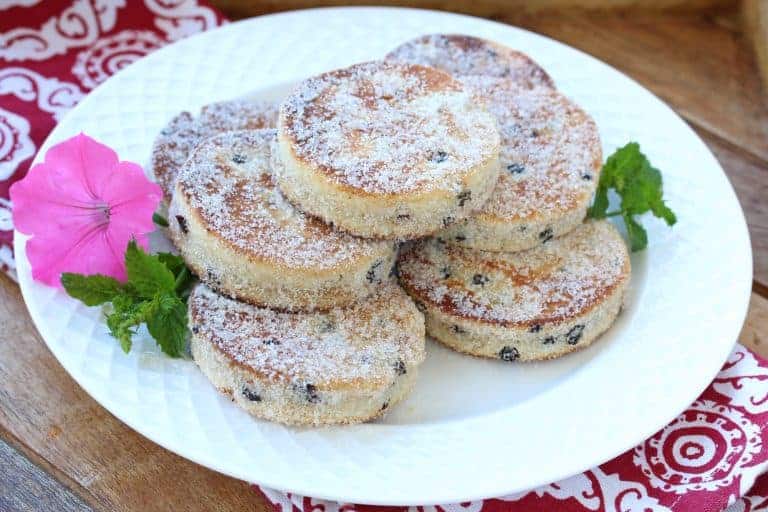
What Are Welsh Cakes?
Welsh cakes, also known as bakestones or “picau ar y maen” in the Welsh language, are popular, traditional Welsh baked goods that are flat, round, and resemble griddle scones. They are traditionally made from flour, lard, sugar, and dried currants and often a hint of warming spices like cinnamon and mace. They’re cooked on a griddle or heavy skillet which gives them their characteristic slightly crispy exterior while keeping the interior soft and meltingly tender. Once cooked they’re coated in sugar and served warm. An important and beloved part of Welsh culinary heritage, Welsh cakes are enjoyed as an everyday treat or served on special occasions like St. David’s Day.
A Brief Introduction to Wales
Before we get to the recipe, let’s talk just briefly about the beautiful country that is home to these delicious Welsh Cakes. Wales is a breathtakingly scenic country with mountainous national parks, glacial landforms, rugged coastlines, some of the most striking fortresses in the world, picturesque villages, and steeped in a rich Celtic culture.
And then of course there is the Welsh language which is near maddening to anyone who can’t speak it (99.999% of the world). Yet even the mind-boggling, tongue-twisting language is an endearing aspect of this beautiful country.

I visited Wales regularly during the 6 years I lived in England and my husband also lived in Wales for nearly a year as a young adult. There’s a small village in Wales that has the longest place name in the UK and second longest in the world. Todd prides himself in being able to say the name, all 58 letters, at break-neck speed and without even the slightest hiccup: Llanfairpwllgwyngyllgogerychwyrndrobwllllantysiliogogogoch.
And just in case you don’t believe me, we visited the village this Summer and I took a picture of the sign:
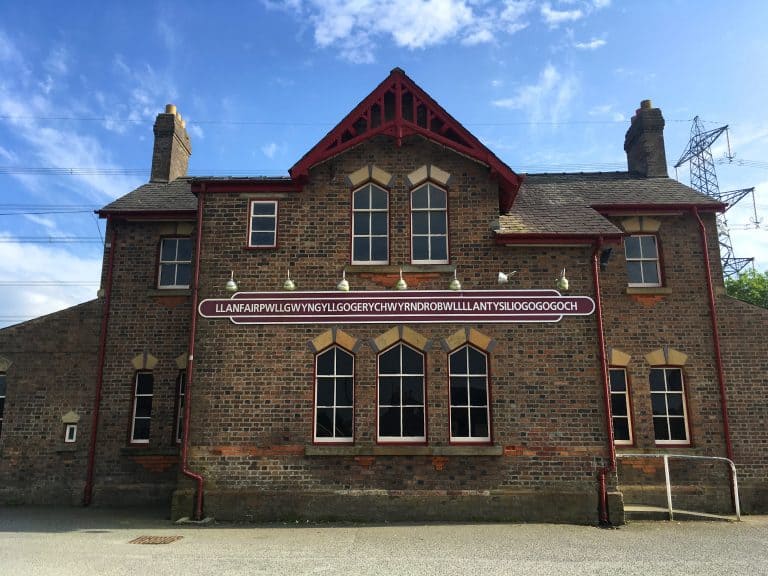
So you have these charming quirks in Wales and then you also have the jaw-dropping, awe-inspiring landscapes and architecture. Todd and I both absolutely love Wales and just got back from a recent vacation there with our kids, focusing this time on North Wales. Here are just few representative pictures of the area.
Below left: The Great Orme. Below right (top and bottom): Snowdonia National Park.

Below are a few of Wales’ most striking and famous castles, all built by Edward I in the 13th century.
Below top left: Caernarfon Castle, where historically the Prince of Wales was crowned and that tradition was resumed with Prince Charles. Below top right: View from Harlech Castle.
Below bottom left: Beaumaris Castle, considered the finest textbook example concentric castle design in the world. Below bottom right: Harlech Castle, also considered an example of the finest medieval castle designs in the world.
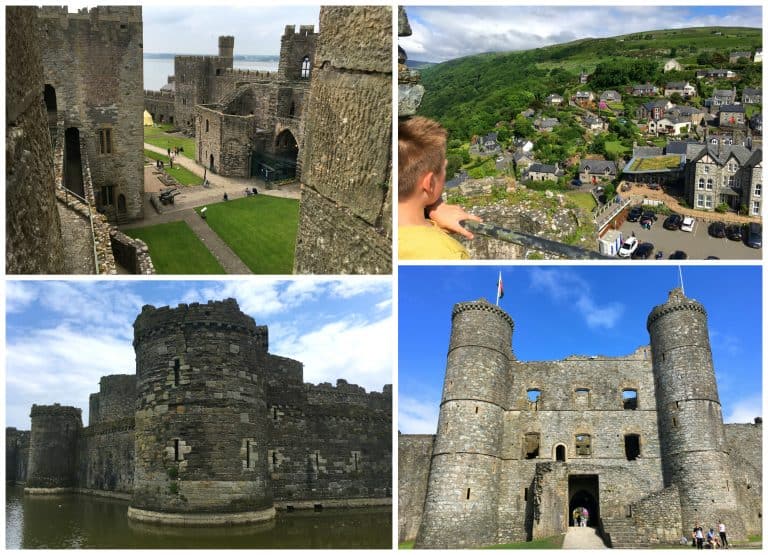
Below: Conwy Castle, considered one of the finest defensive castle designs in the world.
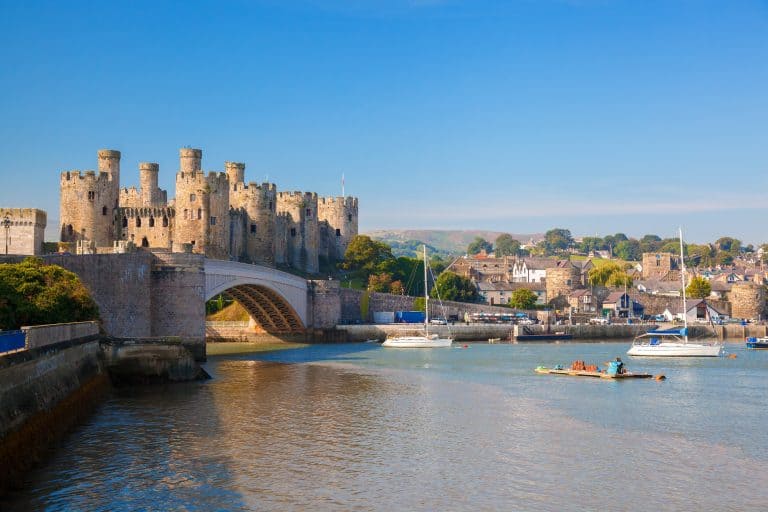
The Killebrew’s at Beaumaris Castle.
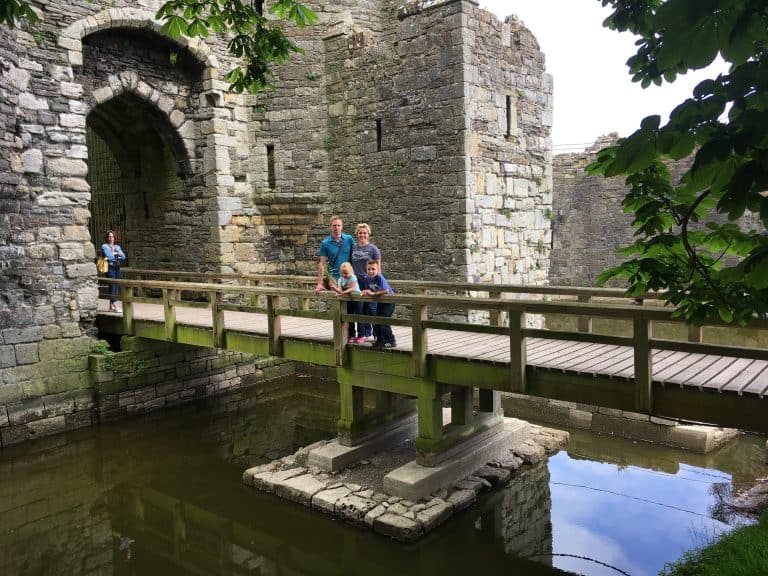
Wales also has a special place in my heart because it’s home to many of my ancestors. My great grandparents on my father’s maternal side were from South Wales and I also have a long line Welsh ancestry in North Wales that goes back to Roman times.
It was my great-grandparents, the Thomas Family from Glamorganshire, Wales, who immigrated to the United States, to Utah, in the late 19th century.
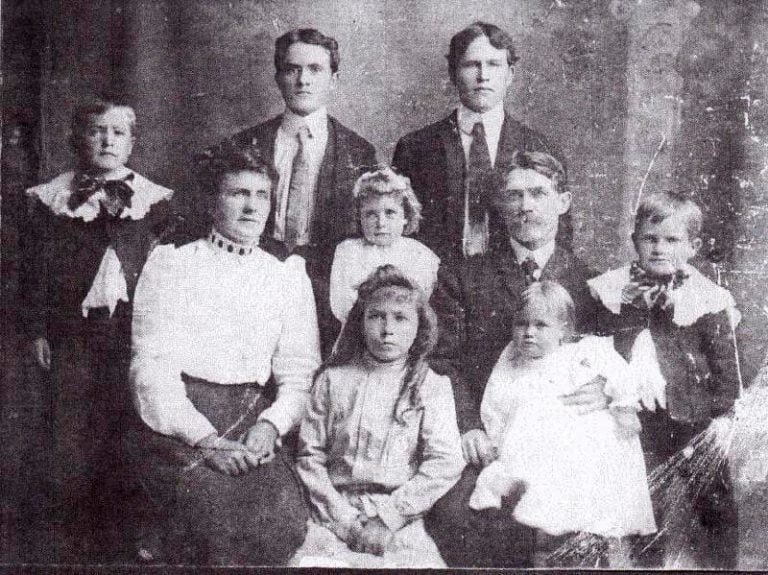
I’ve always wished some of my great grandmothers would have left some journals or recipes to pass down. What a treasure that would be! Nevertheless, I like to imagine my Welsh great-grandmother, Dinah, making these Welsh cakes in her kitchen and her children enjoying them hot off the griddle and dusted in sugar.
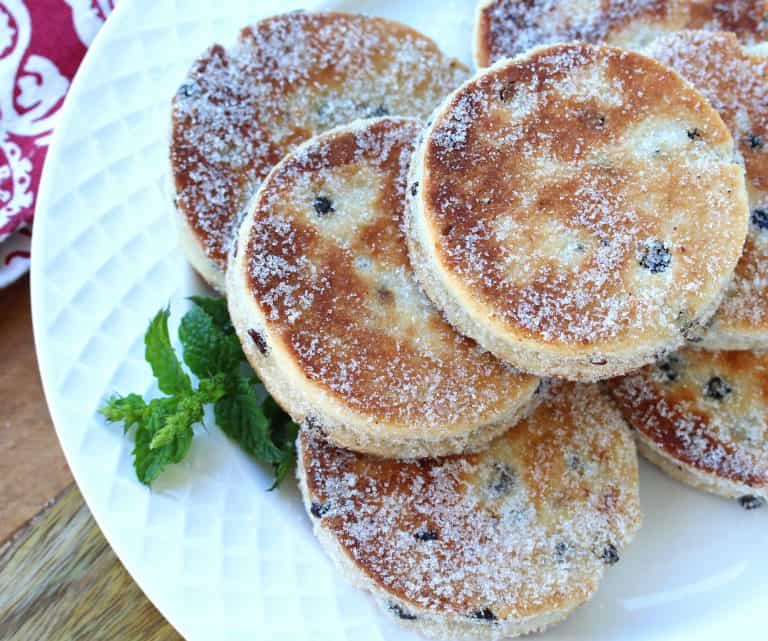
So in honor of the beautiful country of Wales and my Welsh heritage, I’m sharing a very authentic recipe for traditional Welsh Cakes. In Wales these are also known as “bakestones” because traditionally they were cooked on a bakestone which is a cast iron griddle that was placed on the fire or stovetop.
If you’ve never had Welsh Cakes before, I think you’ll agree once you try them that they’re quite different from anything you’ve had before. With their unforgettably flaky, tender, almost melt-in-your-mouth texture that’s punctuated with sweet currants and laced with a wonderful hint of mace, Welsh cakes are simply irresistible.
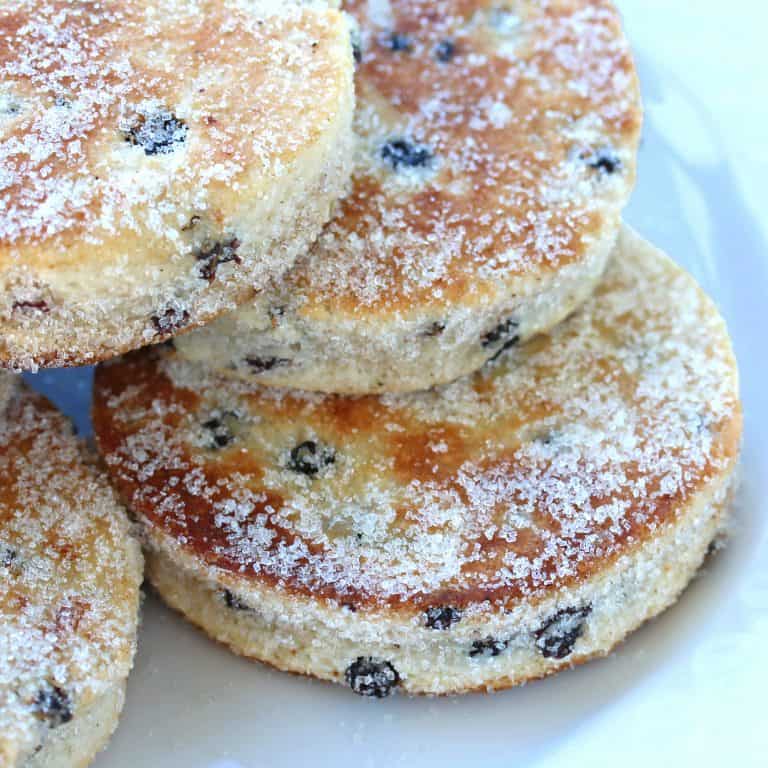
And if you have had Welsh cakes before but your opinion (whether or good or bad) is based solely on store-bought ones, set that opinion aside because I promise you you’ll form a whole new opinion once you’ve tried homemade ones. I’ve had store-bought Welsh cakes on a couple of occasions and I don’t care for them.
But…HOMEMADE…that’s an entirely different story. I am IN LOVE with these traditional homemade Welsh cakes!! Let me say it again: NOTHING compares to the traditional homemade version of these cakes using real lard and mace! They are FABULOUS. Just trust me on this enough to give them a try.
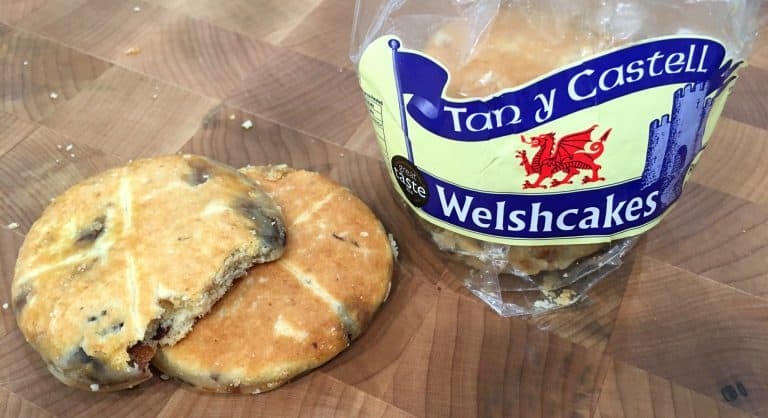
How to Make Welsh Cakes
Use lard. Do not substitute with additional butter. Lard makes ALL the difference in the texture. I repeat: Lard makes ALL the difference in the texture. I highly recommend making your own lard – it’s super easy! Learn How to Make Lard.
Use dried currants. In spite of their name, they’re actually not dried currants at all but rather a variety of raisin known as zante raisins. They’re much smaller than regular raisins, not as cloyingly sweet, and are firmer in texture (regular raisins will be too large and too mushy in these). Dried currants are a staple in traditional British baking and a must for making Welsh cakes.
Use mace. Don’t substitute nutmeg. Mace is a wonderfully aromatic and flavorful spice that was commonly used generations ago but is unfortunately less common today. Its really adds a special and nostalgic touch of old-fashioned flavor.
Use caster sugar. This is also critical for the texture. Since these Welsh cakes are cooked pretty quickly, regular granulated sugar will not have time to dissolve and the texture will be grittier as opposed to that smooth, almost melt-in-your mouth consistency we’re after. Caster sugar is ultra-fine sugar and dissolves very quickly. You can buy caster sugar or very simply make your own by running regular sugar through the blender until very fine. Do NOT use powdered sugar – it contains cornstarch and is not the same thing.
Traditional Welsh Cakes Recipe
Let’s get started!
In a bowl combine the flour, sugar, baking powder, salt, mace and cinnamon. Mix in the lard and butter using your fingers or a food processor until the mixture resembles coarse crumbs.
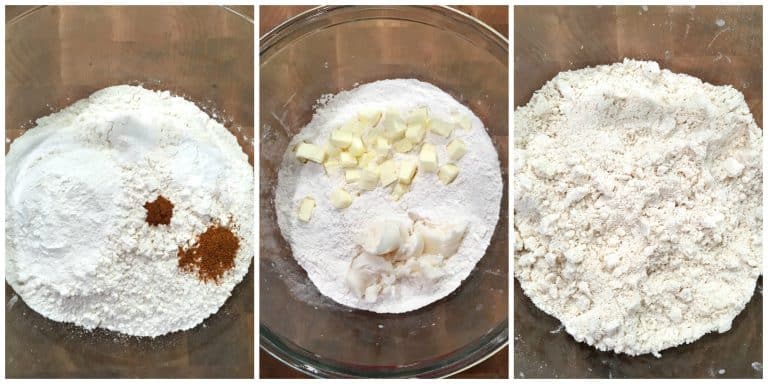
Add the currants and stir to combine. Add the beaten egg and work it into the mixture adding a little milk as needed until you have a soft dough. It should not be wet or sticky.
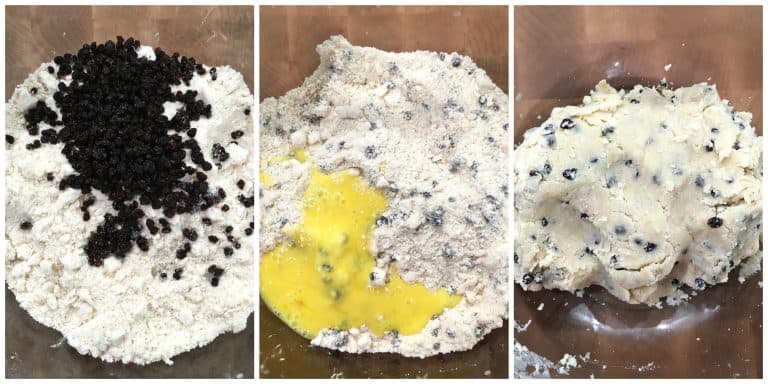
Wrap the dough and refrigerate for 30 minutes. (Dough can be made well in advance and chilled until ready to use.)
Roll the dough out onto a floured or non-stick surface about 1/4 inch thick. Cut out rounds using a biscuit cutter.
Gather up the scraps, knead together and roll out again to cut the remaining rounds.
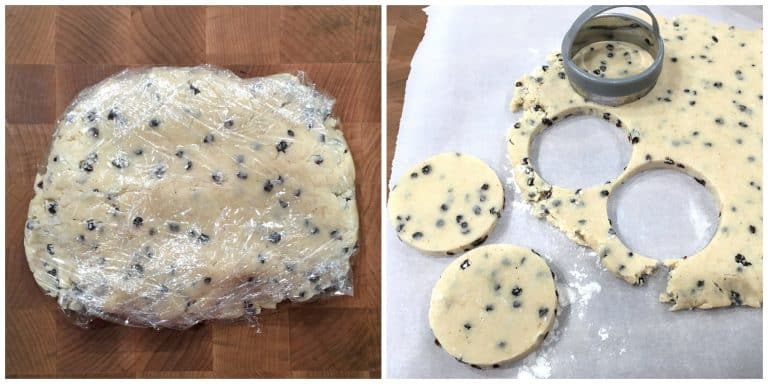
Heat and lightly butter a cast iron pan over medium heat. (I use and love my Lodge cast iron pan for these Welsh Cakes.)
Add the cakes and cook on each side until lightly browned, about 3-4 minutes (lower the heat if needed to prevent the outside from burning before the interior is done).
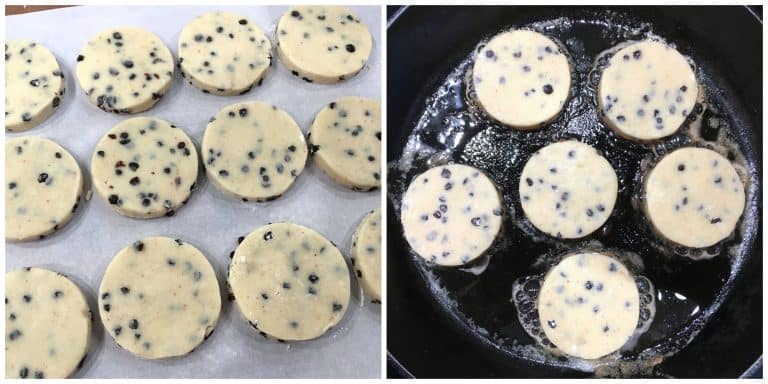
Once the Welsh cakes are done, remove them from the pan and let them cool for a minute.
While the Welsh cakes are still warm, place them in a small bowl of sugar to coat all sides.
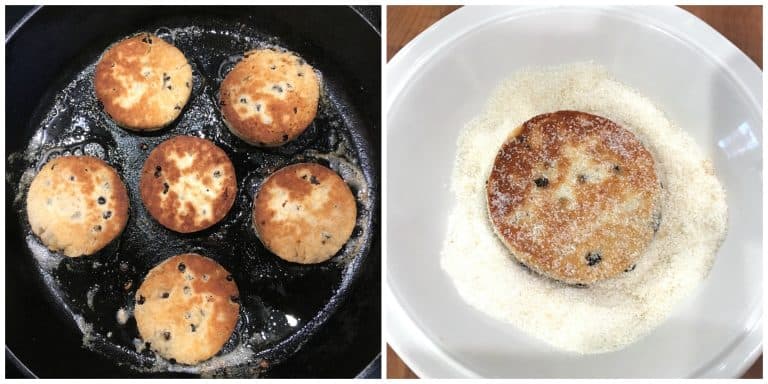
Best eaten while a little warm. Reheat Welsh Cakes in a pan, toaster, or warmed oven (or if in a hurry, in the microwave for a few seconds).
Enjoy!
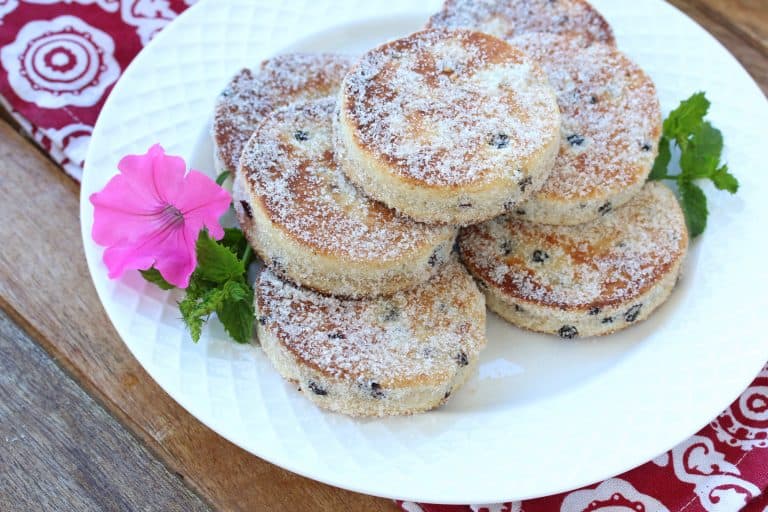
For more traditional Welsh and British bakes be sure to try my:
- Bara Brith
- Treacle Tart
- Sticky Toffee Pudding
- Spotted Dick
- Chelsea Buns
- Cornish Fairings
- Victoria Sponge Cake
- Hot Cross Buns
- Mince Pies
- Lardy Cake
- Scottish Shortbread
- Flapjacks
- Parkin
- Eccles Cakes
- Crumpets
Save This Recipe
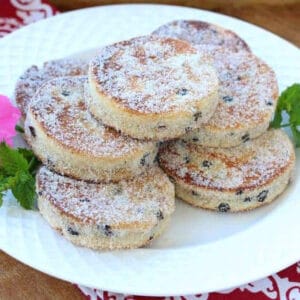
Traditional Welsh Cakes
Ingredients
- 2 cups all-purpose flour
- 1/3 cup caster sugar (do not substitute) (to make your own, pulse granulated sugar in a blender until ultra fine. Do NOT use powdered sugar)
- 1 teaspoon baking powder
- 1/2 teaspoon ground mace ,(a highly fragrant, flavorful spice used in a lot of traditional baking. STRONGLY recommended but can substitute nutmeg if necessary)
- 1/4 teaspoon salt
- 1/8 teaspoon ground cinnamon
- 2 ounces lard , chilled (about 4 tablespoons) NOTE: Lard is critical for the wonderful texture of Welsh Cakes
- How To Render Your Own Lard! (it’s WAY cheaper and better)
- 2 ounces butter , chilled and cubed
- 1 large egg , lightly beaten
- 1/2 cup dried currants
- 2-3 tablespoons milk
- granulated sugar for finished cakes
Instructions
- In a bowl combine the flour, sugar, baking powder, salt, mace and cinnamon. Mix in the lard and butter using your fingers or a food processor until the mixture resembles coarse crumbs. Add the currants and stir to combine. Add the beaten egg and work it into the mixture adding a little milk as needed until you have a soft dough. It should not be wet or sticky. Wrap the dough and refrigerate for 30 minutes. (Dough can be made well in advance and chilled until ready to use.)
- Roll the dough out onto a floured or non-stick surface about 1/4 inch thick. Cut out rounds using a biscuit cutter. Gather up the scraps, knead together and roll out again to cut the remaining rounds.
- Heat and lightly butter a cast iron pan over medium heat (I lightly butter it to later help the sugar adhere to the cakes when they’re sprinkled). Add the cakes and cook on each side until lightly browned, about 3-4 minutes (lower the heat if needed to prevent the outside from burning before the interior is done).
- Let them cool for about a minute. While the Welsh cakes are still warm, place them in a small bowl of sugar to coat all sides. Best eaten while a little warm. Reheat Welsh Cakes in a pan, toaster, or warmed oven (or if in a hurry, in the microwave for a few seconds).
Nutrition
Originally published on The Daring Gourmet October 30, 2018



















So yummy with my afternoon tea. Warmed up in the toaster oven just fine!
Fantastic, Terri, I’m so glad you enjoyed these – I LOVE Welsh cakes!
Made these yesterday for the first time ever. They came out great! Tasted just like the ones I had in Cardiff several weeks ago. Thank you for sharing this recipe.
Question– do you have any recipes for other Welsh Cake varieties, other than the traditional ones with sultanas? Maybe an orange and chocolate Welsh cake or a cinnamon one? Just curious. Thanks!
I’m so glad to hear that, Nick, thank you very much! I don’t have recipe variations posted on my site no, but you can absolutely change up the add-ins. Things like mini chocolate chips, candied orange peel, candied ginger…. I have recipes for these: https://www.daringgourmet.com/how-to-make-candied-orange-and-lemon-peel/ and https://www.daringgourmet.com/how-to-make-crystallized-ginger/.
The recipe handed down in our family states that the raisins (I prefer to use sultanas) should be soaked in tea prior to use. This makes them plump and delicious. Just drop them in to boiling water that has a teabag added and a teaspoon of sugar. To use, drain then add as per recipe. You will need a little less liquid to reach the right consistency. Delicious.
i need a some help with this. i cannot eat mammal meat or lard. i have a weird something that makes it impossible for me to digest mammal meat or lard. can i use ghee or vegetable shortening instead of lard? my dad’s grandmother spoke fluent Welsh. my dad spoke a little.
Hi Julia, yes, either of those will work as substitutes. Happy baking!
so regular salted butter would be okay also?? just found this recipe can’t wait to try it
Hi Verna, yes that’s fine, just omit the added salt if you’re using salted butter. Happy cooking! :)
I would love to make and try Welsh cakes as I have a bit of Welsh ancestry. However, currents are banned in the United States of America. We have dried cranberries, different kinds of regular raisins but no currents. Oh well.
Hi Bee, as I explain in my post, “dried currants” aren’t actually dried currants. It’s what the Brits refer to as a tiny variety of raisin also known as zante raisins. If you click on the dried currants in the ingredients list it will take you to zante raisins on Amazon. So you are free to make them! :) On a side note, currants are no longer banned in the United States. I grow them in my garden here in the U.S.. The ban was started in 1911 and was lifted several years ago.
Just out of interest – how can a *language* be “maddening” to anyone…? I’d be surprised to hear that comment being levelled at any other language or culture without it being seen as deeply problematic. And Welsh shouldn’t be any different.
Hi Phil, as a Celtic language, specifically of the Brythonic branch, with very different linguistic roots and structures (very little Latin or German influence) and only recently acquiring English loan words, Welsh is a particularly challenging language for most people, which any objective person would understand and even the Welsh good-naturedly joke about (my husband lived in Wales and we visit frequently). By definition maddening includes exasperating and frustrating, which is how most people regard any language they perceive as difficult. How is that “deeply problematic”? In any case, my comment was clearly meant to be taken in good humor and is followed by my statement, “yet even the mind-boggling, tongue-twisting language is an endearing aspect of this beautiful country.” I have two sets of great grandparents who came from Wales. It is an integral part of my heritage and a country I deeply love. Let’s not take offense where none was intended.
I’m also a Thomas from Glamorgan! Mountain Ash to be exact, though my family moved away and settled in Essex, England. Going to try to make these tonight, ready for St. David’s day tomorrow!
Hoooray, that’s wonderful, Oliver! I’ve got a great recipe for Glamorgan Sausages that has been on my “to do” list forever to publish on my site (along with Welsh rarebit). If you haven’t already tried Glamorgan sausages I think you’ll love those too. Happy St. David’s Day, fellow Thomas! <3
Are these supposed to rise? Mine stayed quarter inch thick. Very tasty though.
Hi Lynne, no they don’t really rise, not very discernibly. I’m happy you enjoyed them, thank you!
So GOOD!!!!!!!
Thank you so much, Luna! <3
first time. eating one and cooking these.
mine aren’t as thick as yours and I found hard to flip without crumbling but once I got the hang of it was fine.
quite tasty we enjoyed very much.
Thank you, Joanne, I’m so glad you enjoyed them! Thicker will be easier to flip so I would just increase the thickness next time.